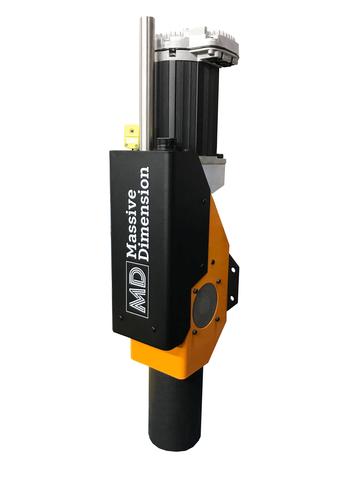
The MDPH2 pellet extruder by Massive Dimension. Image via Massive Dimension.
[ihc-hide-content ihc_mb_type=”show” ihc_mb_who=”reg” ihc_mb_template=”3″ ]
[vc_row][vc_column][vc_column_text]Filament-based 3D printers are restricted due to the limited amount of material they can extrude to build a model. Therefore, making large (or massive) objects can take a considerable amount of time. A pellet extruder, coupled with a nozzle of larger than usual diameter, bypasses the extrusion limit to 3D print large objects more efficiently.
Fused particle fabrication
As more innovative uses of 3D printing in construction, architecture, and prototyping come forward, large-format 3D printing is becoming more relevant.
Large-format 3D printing is an FDM/FFF methods used to fabricate models with dimensions ranging between a life-size prosthetic to a pedestrian bridge. Layer heights using a large-format 3D printer can range between 1mm-25mm because the focus of large-format 3D printing is the size and not resolution.
Thicker layer heights can reduce the printing time. However, in FDM/FF technology the extrusion rate is limited to due the filament filament feed system. A pellet extruder breaks through these limitations and can extrude high volumes of materials through the nozzle for 3D printing. Pellet feeding technology is also known as fused particle fabrication (FPF) or fused granular fabrication (FGF).[/vc_column_text][vc_column_text]
MDPH2 pellet head extruder
Making the filament from recycled plastic requires melting the plastic. This process degrades the mechanical properties of the polymer and reduces the recycling to five cycles if no fresh material is added.
A way out of this problem is removing the need to convert waste plastic into filament. Massive Dimension’s MDPH2 pellet head extruder does just that. It uses pellets, flakes or shreds which can be fed through a hopper (or some other feeding system). These pellets are melted by the MPH2 hotend to 3D print models.
The MDPH2 can be attached to most FDM/FFF system. It is capable of reaching temperatures up 450°C which means it can extrude engineering-grade polymers such as PEEK and ULTEM. Furthermore, the extruder can be attached to most XYZ movement systems and industrial robots.
Massive Dimension’s pellet extruder is available to buy for $4,949. It comes with two extra nozzles, motor driver, and power supply cable.[/vc_column_text][/vc_column][/vc_row]
[/ihc-hide-content]
Researchers have developed a way to consistently produce a special type of stainless steel known…
APF designed to enable superalloy development in direct energy deposition. Nikon has announced the release of…
Schoeller-Bleckmann Oilfield Technology GmbH (SBOT), based in Ternitz, Austria, has completed the first expansion stage…
The companies will work together to develop new standards for the energy industry using cold…
Fortius Metals, a company located in Colorado and specializing in supplying metal wires for additive…
ADNOC Gas has developed one of the energy industry’s largest digital libraries of critical components,…
This website uses cookies.